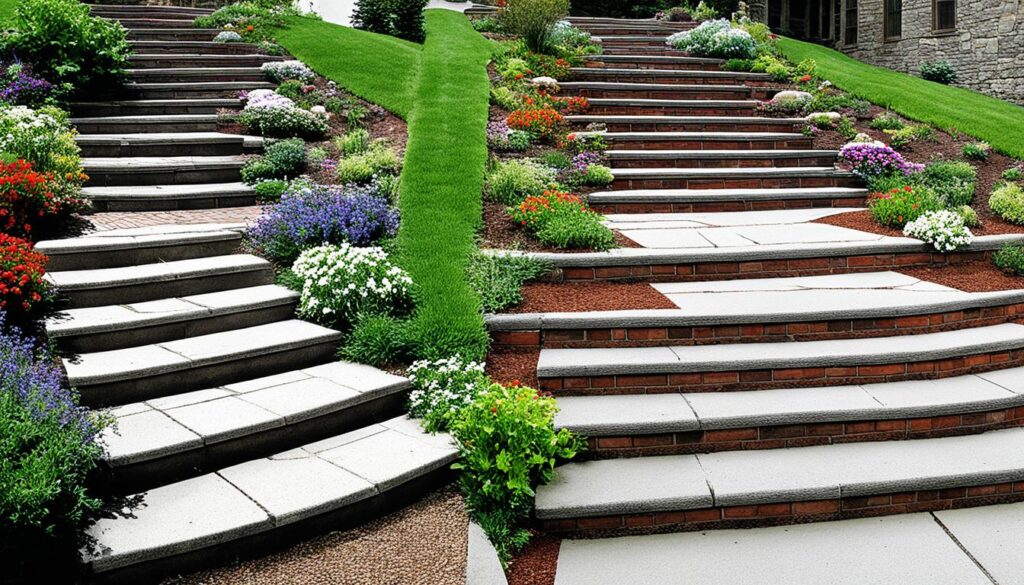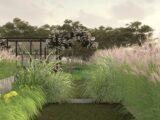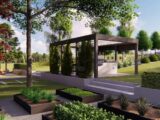Ever thought about what makes a great garden stand out from the rest? The key is knowing about garden architecture and landscape design. These core ideas, developed over many years, turn your outdoor areas into peaceful retreats. But what are these vital principles and how do you use them to build a garden that shows your personal style?
This piece will cover eight essential principles that have helped the author in 28 years of garden-making. From creating significant areas to the choice of plants, these tips will let you design a beautiful and functional garden. Want to learn the secrets of sustainable gardening and permaculture design? We’ll go through the main principles that will lift your outdoor living spaces to a new level.
Obey the Law of Significant Enclosure
In garden architecture and landscape design, «significant enclosure» is key. The first source explains this concept. It says we feel enclosed when there’s a certain ratio between vertical edges and horizontal spaces. This makes us feel at peace and deeply connected with the outdoors.
Vertical Edges and Horizontal Spaces
The position of vertical edges matters a lot in garden architecture. Things like walls, fences, and plants create boundaries. They make spaces feel enclosed and private. Using the one-third rule helps blend human-made and natural elements. It brings a sense of seclusion that feels just right.
Creating a Sense of Refuge
Enclosure isn’t just about design. It’s a way to make outdoor living spaces feel like a safe haven. The right mix of vertical edges and horizontal spaces can wrap people in nature. It offers a quiet escape from the busyness of the world. Plus, it deepens our bond with the natural world.
Follow the Regulating Line
In garden architecture and landscape design, the «regulating line» is key. It establishes order and harmony in your outdoor areas. This line, drawn by a piece of architecture or landscape feature, connects and organizes your design.
Establishing Underlying Order
The regulating line brings order to your garden. It guides the placement of structures, features, and plants. Whether a wall or a row of trees, it unifies your garden architecture.
Using Distinctive Landscape Features
Find and use distinctive landscape features for success with the regulating line. These may include streams, rocks, or man-made elements like pergolas. Aligning design with these features helps create harmony.
Utilize the Golden Rectangle
In the world of garden architecture and landscape design, using the Golden Ratio and its cousin, the Golden Rectangle, is key. It helps create a beautiful and pleasing look. This approach is all about balance and proportion, making it a favorite of designers and artists.
Achieving Pleasing Proportions
The Golden Rectangle has a ratio of 1:1.6. It’s great for anyone designing outdoor spaces. It ensures everything from the patio size to the lawn area looks balanced and harmonious.
Adding the Golden Rectangle into your garden architecture ensures all features work together perfectly. This makes your garden or outdoor area not just visually appealing but also deeply meaningful. It links people closely with nature.
| Principle | Description | Practical Application |
|---|---|---|
| Golden Rectangle | Aesthetic ratio of 1:1.6 that many find pleasing. | Commonly used in garden architecture and landscape design for creating balanced spaces. |
| Proportions | The connection between size, shape, and scale in design. | Makes sure elements in designs work together for a unified look. |
| Balance | Arranging visual elements for a stable and unified look. | Helps in creating visually appealing and harmonious outdoor designs. |
Adhere to Church’s Step Design Ratio
When we talk about garden design, the step design ratio from Thomas D. Church is key. Church has been a big name in bringing the California style to life. He shared a simple guide for making steps that look good and work well.
According to Church, the total of twice the height of the riser (this is the vertical part) and the tread width should be 26 inches. For example, if the riser is 5 inches tall, the tread should be 16 inches wide. This step design ratio ensures people move easily and it makes your outdoor area look better. It’s all about garden architecture and landscape design.

Using Church’s ideas in your garden architecture and landscape design plans can really improve your outdoor space. This ratio isn’t just for looks. It also makes steps safe and comfy to use in your garden or yard.
Embrace Large-Scale Elements
In garden architecture and landscape design, using large-scale elements is significant. It transforms your outdoor spaces into stunning areas, full of grandness. The main idea here is that bigger is often better in choosing your landscape’s size.
Filling Outdoor Spaces
When designing, think about wider staircases, longer pools, or higher pergolas. By adding large-scale elements, you achieve a perfect harmony. This balance mixes built features with garden architecture, giving outdoor spaces a purpose and charm.
Creating a Sense of Grandeur
Adding large-scale elements makes your landscape design iconic and grand. It makes visitors feel surrounded by incredible beauty. With features like tall water displays and wide terraces, your outdoor spaces become strikingly beautiful.
Plant Big to Small
One key rule in garden design is to «plant big to small.» This strategy makes your garden look great. It also helps in organizing your outdoor area better.
Establishing Overall Structure First
Start with the big things, like trees. They form the base of your garden’s look. Big plants set the stage for where smaller ones go. This helps you see how your landscape will come together well.
Practical Considerations
This planting method is also practical. Big trees need careful planning to plant. They may need special tools, many people, and a lot of space. Planning this ahead makes putting your garden together easier and better.

garden architecture Principles
In the world of garden architecture and landscape design, key principles help designers mix aesthetics with functionality. They also focus on a sustainable design approach. Unlike traditional art, landscapes change over time. They grow and evolve with the environment and how people use them.
Harmonizing Aesthetics and Functionality
Landscape designers aim for designs that look great, work well, and support the environment. They use a careful process that looks at the land, plants, and what people need. This lets them make places that are beautiful, fit in with their surroundings, and serve the practical needs of the owner.
Sustainable Design Approach
Today, designers focus on sustainable design in garden architecture and landscape design. They use methods like xeriscaping and permaculture design to make spaces that need less upkeep, less water, and are kind to the Earth. By using native plants, eco-friendly materials, and efficient resources, designers can make gardens that are sustainable and support the local ecosystem.
Leverage the Elements of Design
Exploring garden architecture and landscape design requires knowing the critical elements. These shape how we feel and move within outdoor spaces. They allow us to create places that draw us in and make us feel at home.
Line: Defining Spaces and Movement
Lines are essential in garden architecture and landscape design. They outline areas, connect elements, and guide movement. Well-placed lines lead us through the space, revealing its beauty as we go.
Form: Three-Dimensional Masses
The shape of trees, shrubs, and structures adds depth to your garden. By focusing on their three-dimensional aspect, your landscape design becomes more complete. It brings together space, light, and shadow in a pleasing way.
Texture: Visual and Tactile Qualities
Plant materials and hardscapes change how your garden architecture feels and looks. Mixing textures adds depth and contrast. It also invites people to connect with the space through touch.
Color: Evoking Moods and Emotions
Color deeply influences how a space feels. It can make your landscape design feel peaceful, lively, or evoke other feelings. This affects how one enjoys the garden architecture overall.
Apply Design Principles
In garden architecture and landscape design, unity, harmony, scale, proportion, balance, and symmetry are key. They help make outdoor spaces look beautiful and work well. These design rules let you make gardens that please the eye and fit into nature smoothly.
Unity and Harmony
Unity brings together all parts of a garden. They must blend to make a whole space. Harmony is how we pick and place plants, paths, and buildings to look good together.
Scale and Proportion
Size and how things fit together are vital. They make sure your space is balanced and interesting. A mix of big and small items brings both majesty and coziness to your garden.
Balance and Symmetry
Balance and symmetry add order to a garden. Symmetry uses even designs to look formal and elegant. Without matching sides, a garden can still look balanced but more natural and exciting.
By using these garden architecture and landscape design rules, your outdoor spaces will turn into beautiful places. They will unite beauty with practicality. Love using unity, harmony, scale, proportion, balance, and symmetry to enhance your garden.
Create Outdoor Rooms
In the world of garden architecture and landscape design, making «outdoor rooms» is key. You use lines, like those in hardscape and plants, to shape spaces. Doing this makes the area feel like a cozy spot where you’re connected to nature.
Enclosures and Vistas
The edges of plant beds and hardscape mark the start of these outdoor rooms. They pull everything together, blending the built things with nature in a nice way. These lines not only show where the room ends but also help showcase nice views by drawing your eyes to them.
Functional Zoning
Making these outdoor rooms pretty also helps with how we use the space. When you right place these areas for eating, sitting, or playing, it flows better. This smart arrangement makes outdoor living spots more fun and easy to use.

Incorporate Hardscaping
Make your garden more beautiful and useful with hardscaping. This includes pathways, walls, steps, and more. By mixing these elements, you blend man-made structures with nature, making a peaceful outdoor area.
Paths and Walkways
Paths and walkways direct how people move through your yard. They also draw attention to certain areas and add to the adventure of exploring. Use different materials like stone or pavers for a varied, interesting look. The right placement can highlight the beauty of your garden.
Retaining Walls and Steps
Retaining walls and steps help deal with ground slopes in a beautiful way. Use materials like stone or wood for their construction. Design these features with safety and comfort in mind for those using them.
Water Features and Structures
Water features and structural elements combine to form a peaceful space. You can have fountains, ponds, or waterfalls for a calm sound. Adding structures like trellises or pergolas enriches the area. These items are not just beautiful but also improve your yard’s layout.
Emphasize Sustainable Practices
Understanding garden architecture and landscape design introduces us to sustainable practices. Even when not directly covered, the tips provided can help make outdoor spaces eco-friendly. They guide us to use resources wisely.
Xeriscaping is one key practice. It involves choosing plants used to dry conditions from the area. Doing this lowers the amount of water needed. Permaculture design is another useful tool. It helps improve biodiversity, soil, and saves resources. This makes the landscape more natural and easy to maintain.
When sustainable techniques are part of design, outdoor areas get a big boost. They look better and help the environment. This way, we create gardens that are both beautiful and planet-friendly. Such an approach benefits everyone in the long run.



